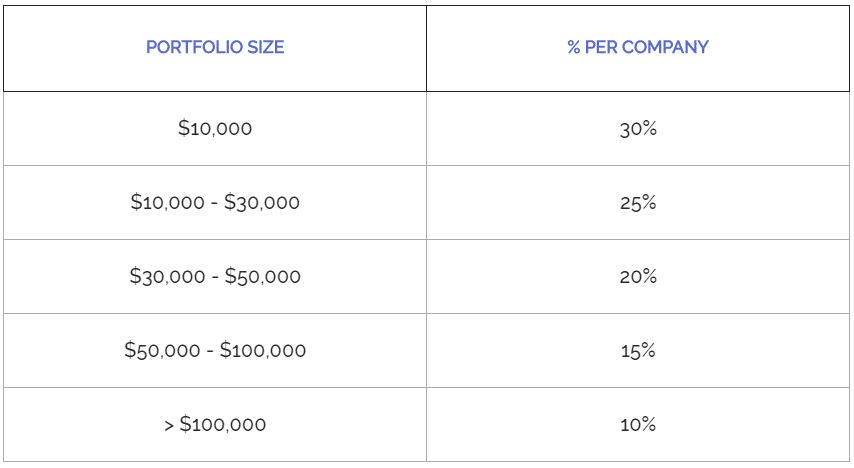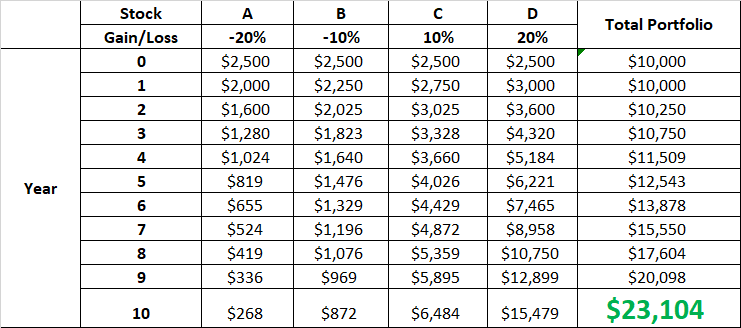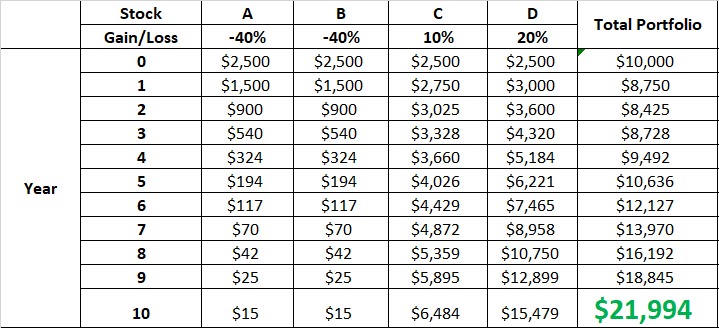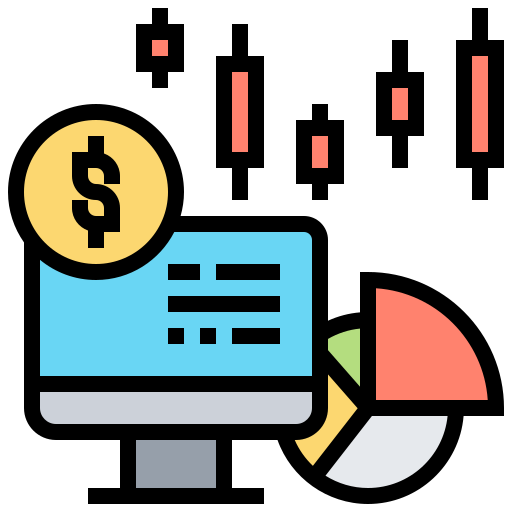Some times, I hear people who are investing...
...but yet, they don't know any of the companies they invested in.
They were blindly following others, they never read a single financial statement of the company...and worse they go ALL IN into one stock - thinking it is their golden ticket to building wealth.
Being an investor in the stock market, is not about the excitement when stock prices goes up or the sorrow when stock prices falls. That's gambling - you should never be emotional about the stock market.
In fact, it is about building a portfolio of quality companies.
In this blog post, I reveal the 5 symptoms of bad investing habits in the stock markets.
1. You Lose Sleep At Night

As you lie on your bed, you are constantly worried about how the stock price is moving or will move the next day...
There are only two reasons why you are worried over investing:
- Your portfolio is made up of companies that you blindly followed and don't understand
- You put too much money into a single position, whether it is call options, stocks, or leverage.
I cannot think of another reason why anyone would be losing sleep over investing.
Investing in the stock market is to help you exchange money for more money, and not time for money.
Never let the stock market affect the quality and quantity of our time.
All we have to do is to design a portfolio, and avoid investing in poor quality companies.
Designing a portfolio is the easy part - never put too much money into a single stock.
That's it, it doesn't take any intelligence, just discipline.
But here's the question, how do I know how much I can put in a single stock?
Well, that really depends on your portfolio size.

The above is a guideline that I provided for my students.
The logic is simple, if you are starting out with a smaller portfolio, then you can afford to be more concentrated, with a focus on growth.
But as your portfolio gets bigger, you might want to consider diversifying your portfolio and focus on protection.
In any case, feel free to tweak the percentage depending on your investment strategy/philosophy - as I said, this is merely a guideline.
Now, for the next part - avoid investing in poor quality companies.
Avoiding poor quality companies boils down to having a financial checklist.
If a company passes the financial checklist, then very likely it is a company with good fundamentals.
I will not go into too much detail on this, but here's the checklist that I personally use.

Get Your 8-Point Checklist!
So that you know what stocks
to avoid investing in.
2. You Fail The "Buy Back" Test

Let me give you a quiz.
On week 1, you bought 100 ABC shares at $200.
On week 2, you sold the 100 ABC shares at $250.
On week 3, you bought 100 ABC shares back at $250.
On week 4, ABC shares falls to $230
Q1. How much did you actually buy 100 ABC shares at?
a. $200
b. $230
c. $250
Well, the answer would be $200.
(Because, when you sell at $250 and buy back at $250 - it is can be treated as that transaction didn't take place.)
Q2. On week 4, when the share price fell to $230, what is your unrealised P/L in reality?
a. $2,000
b. $3,000
c. $5,000
Well, the answer would be $3,000.
From Q1, we know that you bought the shares at $200. If by week 4, the price is at $230, it means that your profit would be $30 X 100 = $3,000.
Q3. On your brokerage account, what is the price reflected as your purchase price?
a. $200
b. $230
c. $250
This may come as a surprise. The price reflected in your brokerage account is $250.
After all, the brokerage software will only show you the last transacted purchase price, which is when you bought the 100 shares at $250 in week 3.
Q4. On week 4, in your brokerage account, what is the reflected P/L?
a. + $2,000
b. - $2,000
c. +$3,000
Well, the answer is - $2,000.
In week 4, the share price was at $230.
Remember that from Q3, the brokerage software thinks that your purchase price is at $250. Therefore, your brokerage account will reflect a loss of $2,000.
What is the point that I am trying to make here?
Well, I want you to focus on the reality and NOT what your brokerage account show you.
In the above example, the brokerage thinks that you lost $2,000, when in fact, you made $3,000.
Now, let's flip things around.
On week 1, you bought 100 ABC shares at $200.
On week 2, the share price fell to $180, and your playful friend went to help you to sell at $180.
Now, here's the question.
Q1. If you were to buy the shares back at $180, what is your purchase price for ABC shares?
a. $200
b. $180
c. $380
Well, the answer is still $200! Whether your friend was playful or not, as long as you bought back the shares at $180, your purchase price would still be $200!
(If you are thinking about commissions, note that there are no commission charges for US stocks)
But here's the thing.
When the share price fell to $180, you were already having a paper loss of $2,000.
I need you to imagine this scenario, when your friend helped you to sell at $180 - would you be willing to buy it back immediately, knowing that your purchase price would still be the same?
If you were not willing to buy it back, it means that you failed the "buy back" test.
Deep down, you were probably feeling relieved that your friend helped you to cut your losses.
The reason why you felt relieved is probably because you were holding on to either a poor quality company or a company that you didn't understand.
Or here's another reason why you won't buy back immediately.
You are thinking to yourself, "This is a quality company, but maybe the share price can fall further, and I can buy it at a cheaper price."
If you think that the share price can fall further, then why don't you short sell the stock or buy a put option on it? You wouldn't do that, because deep down, you know it is foolish to put a bearish position on a quality company.
Investors look at value and not price.
I know that as long as I bought a quality company at a reasonable valuation, chances are that I will make money over the long term. So even if the share price were to fall, then I will just gladly collect more shares.
So here's the thing, if someone were to sell any of your stocks that are bleeding today - will you be willing to buy them back immediately?
3. You Are Eager To Take Peanut Profits

Albert Einstein once said that the power of compounding is the eighth wonder of the world.
So when you are taking small profits of 5% to 10% on a stock, you could be missing out on the amazing compounded returns.
But when it comes to investing, many people misunderstand where the real compounding comes from.
Some investors may think that the power of compounding comes from reinvesting the dividends they received back into their investment portfolio.
Sure, it is considered compounding - but it is a very weak form of compounding.
Let me explain.
When we invest in stocks, we are effectively investing in a business.
This is such an important concept, that I am going to write it again.
When we invest in stocks, we are effectively investing in a business.
Businesses are essentially a money-making machine and they are the vehicles that truly help us to compound our money.
Here's how a profitable business looks like.

Remember that businesses are essentially money-making machine. And in this case, with every $1 put into the business, there is $5 of revenue.
It probably shouldn't surprise you that the sensible thing for businesses do with the $5 is to reinvest in the business, and NOT to give out dividends. And as a shareholder, you should also demand that this $5 is being reinvested.
This is why companies like Amazon and Tesla don't pay dividends to shareholders, because they are constantly reinvesting back into the business. They know that by reinvesting these profits, it is going to reward their shareholders much more than giving out dividends.
And as the company's earnings increases over the years, the share price increases as well.
That is the real power of compounding in investing, allowing profitable companies that you hold to to do the compounding, and not about reinvesting dividends.
4. You Get Emotional Over A Loss

People tend to get upset when they are wrong. That is natural.
But in the stock market, no matter how brilliant or academically smart you think you are, you are bound to be wrong sometimes.
Heck, even Warren Buffett admitted he had made mistakes.

If one of the greatest investors in the world can make mistakes, why wouldn't we?
But here's the thing - we can make mistakes and still make money in the stock market overall.
That is by having a portfolio, as I mentioned previously.
To illustrate this, let's say you had $10,000 and invested in four different stocks.
Stock A loses 20% every year
Stock B loses 10% every year
Stock C makes 10% every year
Stock D makes 20% every year
The percentage adds up to be zero. But look at what happened after 10 years.

Your $10,000 would have still grown to $23,104.
This is just merely an example to show you that, even if you picked bad stocks like A and B, overall, your portfolio would have still made money.
Let's exaggerate even further. What if you really downright sucked and pick two really bad stocks that lost 40% every year.

Man, your $10,000 would still have grown to $21,994.
Of course, in reality, it is probably quite hard for you to pick stocks that are losing money every year when you are following a financial checklist that helps you to avoid losing companies.

Get Your 8-Point Checklist!
So that you know what stocks
to avoid investing in.
5. You Are Constantly Worried About A Correction

These are for the people who are constantly reading the news, about the financial analyst predicting a market correction.
Let me save you the effort - the market correction and even crashes, will eventually come from time to time.
And listening to financial analysts that predict the market corrections - is like listening to boy who cried wolf. Eventually, they will be right and the real wolf will come.
So if you are constantly worried about a correction/crash, chances are that you have not prepared for them.
Its kinda like if you didn't do your homework, then of course you will be worried if the teacher is going to remember to collect your homework today.
By failing to prepare, then you are preparing to fail.
Remember when I said that we should be emotionless when investing in the stock market.
Well, the truth is that for investors, it is hard not to get excited when we see something like this.

When you see a blood of red like these, you know that it is time to start collecting quality undervalued shares.
But in order for you to prepare yourself for such events, you need to have a watchlist of quality companies and its valuation in the first place.
If you don't, then you should definitely be worried - because you wouldn't even dare to buy any of the stocks.
The starting point? Build a watchlist of quality companies by using a checklist. Feel free to use mine, or of course, you can build your own criteria.

Get Your 8-Point Checklist!
So that you know what stocks
to avoid investing in.
What's Next?

So these are the five symptoms of bad investing habits.
And if you want to become a better investor, you need to start with being aware whether you are exhibiting any of these symptoms.
Now, for obvious reasons, I am not able to cover everything about investing in a single blog post.
So here's what I have done - I have created a free resource hub specially for investing beginners to get started in investing, where I cover everything from stock fundamentals, valuations, portfolio sizing, etc.
And I call it the Stock Investing Hub.

The Stock Investing Hub
Never get lost in your investments again.
Do check it out from time to time, as I am constantly reviewing it for my readers.
And if you like what you read so far, could you do me a favor and click on the share button below to share with those who might enjoy reading this 🙂
